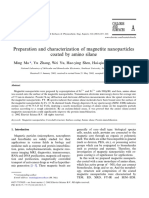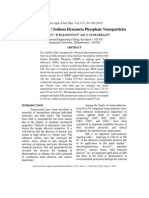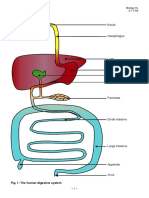0 ratings0% found this document useful (0 votes)
27 viewsLarge Improvement of The Lower Detection Limit of Ion-Selective Polymer Membrane Electrodes
Large Improvement of The Lower Detection Limit of Ion-Selective Polymer Membrane Electrodes
Uploaded by
SahidahIrawanaaa
Copyright:
© All Rights Reserved
Available Formats
Download as PDF, TXT or read online from Scribd
Large Improvement of The Lower Detection Limit of Ion-Selective Polymer Membrane Electrodes
Large Improvement of The Lower Detection Limit of Ion-Selective Polymer Membrane Electrodes
Uploaded by
SahidahIrawan0 ratings0% found this document useful (0 votes)
27 views2 pagesaaa
Original Title
Pretsch Paper
Copyright
© © All Rights Reserved
Available Formats
PDF, TXT or read online from Scribd
Share this document
Did you find this document useful?
Is this content inappropriate?
aaa
Copyright:
© All Rights Reserved
Available Formats
Download as PDF, TXT or read online from Scribd
Download as pdf or txt
0 ratings0% found this document useful (0 votes)
27 views2 pagesLarge Improvement of The Lower Detection Limit of Ion-Selective Polymer Membrane Electrodes
Large Improvement of The Lower Detection Limit of Ion-Selective Polymer Membrane Electrodes
Uploaded by
SahidahIrawanaaa
Copyright:
© All Rights Reserved
Available Formats
Download as PDF, TXT or read online from Scribd
Download as pdf or txt
You are on page 1of 2
J. Am. Chem. Soc.
1997, 119, 11347-11348 11347
Large Improvement of the Lower Detection Limit
of Ion-Selective Polymer Membrane Electrodes
Tomasz Sokalski,† Alan Ceresa,‡ Titus Zwickl,‡ and
Ernö Pretsch*,‡
Department of Organic Chemistry
Swiss Federal Institute of Technology (ETH)
CH-8092 Zürich, Switzerland
ReceiVed August 20, 1997
ReVised Manuscript ReceiVed October 8, 1997
The lower detection limits of ion-selective polymeric mem-
brane electrodes (ISEs) are in the micromolar range except when
sample ion activities are adjusted by using ion buffers, which
maintain low and constant activity via superimposed complex- Figure 1. Schematic measuring setup and concentration profiles in
ation or solubility equilibria.1 Therefore, they are unsuitable membrane at steady state. The potential difference between the aqueous
for many important applications. In contrast, detection limits solutions is a measure of analyte (M+) activities at the membrane
in the picomolar range have been achieved with optical sensors surfaces. In conventional systems (dashed line), slight disturbances
induce a flow of M+ toward the sample, thus biasing its activity at the
on the basis of similar technology and the same ionophores,2
corresponding membrane surface. This is prevented by the gradient
suggesting that there is no fundamental reason for the detection
(solid line) brought about in this work.
limit of analogous ISEs to be worse. Much lower values have
indeed been observed when buffering the sample analyte ion,3 thus indicating that additional processes must be involved.
thus supporting the hypothesis that primary ions leaching from Moreover, if the detection limit were solely defined by the
the sensor membrane determine the lower limit of the measuring transport of primary ions from the internal solution, it should
range of the ISE. This also explains the reduction or even lack be significantly lower for solid contact electrodes. This,
of response toward highly discriminated ions, which prevents however has not been reported so far.
the determination of true selectivity coefficients.4 Theoretical The basic idea of the present work is to prevent primary ions
(Nernstian) response and true selectivity coefficients can, from leaching into the sample by building up a concentration
however, be obtained by buffering the primary ion in the sample gradient in the membrane (Figure 1). The-thereby induced
without influencing the activity of the interfering ion.5 Recent constant flux of primary ions toward the inner compartment
experiments proved that, even for extremely discriminated ions, prevents their passing into the sample. The concentration
Nernstian ISE response is found without buffering the primary gradient is established by choosing an internal electrolyte with
ion as long as its contact with the electrode is avoided.6 low activity of the primary ion and sufficiently high activity of
Although such experiments are important for understanding the an interfering ion. Since any activity change in the inner
selectivity behavior, they do not contribute to extending the compartment would induce a potential change, the low activity
response range in analytical applications. of the primary ion was kept constant by using an ion buffer.
Since the response of polymeric membrane ISEs is, in The responses of two Pb2+ ISEs with the same membrane10
essence, a surface phenomenon governed by bulk equilibria,1b,7 but different inner reference systems11 are shown in Figure 2.
the influence of the aqueous sample composition on concentra- With the conventional inner filling solution, the detection limit
tions in the bulk membrane is negligible if the electrode response for Pb2+ is 4 × 10-6 M, no Nernstian response being observed
is Nernstian.8 Therefore, primary ions most likely leach into for the discriminated Na+ since it is not potential determining
the sample because, together with their counterions, they are under these conditions (Figure 2). On the other hand, with the
extracted from the internal electrolyte and transported across new internal solution, the linear Nernstian response range for
the membrane. Very recently, Mathison and Bakker showed Pb2+ is extended to about 10-11 M and the detection limit is
that such a transport indeed occurs.9 Their model correctly lowered to 5 × 10-12 M (Figure 2). At the same time, the
describes the influence of the composition of the internal response toward Na+ is now Nernstian between 10-2 and 10-3
electrolyte at high concentrations but does not hold for low ones, M, indicating that Na+ is the potential-determining ion at these
† On leave from Department of Chemistry, University of Warsaw, PL- concentrations. Thus, true selectivity coefficients can be
02093 Warsaw, Poland. determined.
‡ ETH Zürich.
(1) (a) Umezawa, Y. Handbook of Ion-SelectiVe Electrodes: SelectiVity (10) The composition of the membrane was 1.31 wt % (14.5 mmol/kg)
Coefficients; CRC Press: Boca Raton, Ann Arbor, Boston, 1990. (b) Bakker, of N,N,N′,N′-tetradodecyl-3,6-dioxaoctanedithioamide (ETH 5435), 0.82 wt
E.; Bühlmann, P.; Pretsch, E. Chem. ReV. In press. % (9.1 mmol/kg) of potassium tetrakis[3,5-bis(trifluoromethyl)phenyl]borate
(2) (a) Lerchi, M.; Bakker, E.; Rusterholz, B.; Simon, W. Anal. Chem. (KTpClPB), 62.5 wt % of bis(2-ethylhexyl) sebacate (DOS), and 35.3 wt
1992, 64, 1534-1540. (b) Lerchi, M.; Orsini, F.; Cimerman, Z.; Pretsch, % of poly(vinyl chloride) (PVC all Fluka) totaling 368.5 mg dissolved in
E.; Chowdhury, D. A.; Kamata, S. Anal. Chem. 1996, 68, 3210-3214. ca. 2.5 mL of tetrahydrofuran. By casting this solution into a glass ring of
(3) Schefer, U.; Ammann, D.; Pretsch, E.; Oesch, U.; Simon, W. Anal. Ø 53 mm, membranes of ca. 85 µm thickness were obtained.
Chem. 1986, 58, 2282-2285. (11) Conventional Pb2+ ISEs were prepared with Philips IS 561 electrode
(4) (a) Umezawa, Y.; Umezawa, K.; Sato, H. Pure Appl. Chem. 1995, bodies and inner filling solutions of 5 × 10-4 M PbCl2 and 5 × 10-2 M
67, 507-518. (b) Bakker, E. Electroanalysis 1997, 9, 7-12. MgCl2. For the construction of the new type of Pb2+ ISEs, the membrane
(5) Sokalski, T.; Maj-Zurawska, M.; Hulanicki, A. Mikrochim. Acta 1991, was glued to PVC tubing. The inner filling solution (10-3 M Pb(NO3)2 and
I, 285-291. 5 × 10-2 M ethylenediaminetetraacetic acid disodium salt (EDTA-Na2))
(6) Bakker, E. J. Electrochem. Soc. 1996, 143, L83-L85. was in contact with the reference element (Ag/AgCl in 3 M KCl) through
(7) (a) Pungor, E. Pure Appl. Chem. 1992, 64, 503-507. (b) Umezawa, a 1 M KCl bridge electrolyte. After the electrodes were conditioned in 10-3
K.; Lin, X. M.; Nishizawa, S.; Sugawara, M.; Umezawa, Y. Anal. Chim. M Pb(NO3)2 for >2 d, measurements were made with a Metrohm NET-
Acta 1993, 282, 247-257. (c) Buck, R. P.; Nahir, T. M.; Cosofret, V. V.; Titrino 721 at 22-23 °C in successively diluted stock solutions of 10-2 M
Lindner, E.; Erdosy, M. Anal. Proc. 1994, 31, 301-312. (d) Bakker, E.; Pb(NO3)2 from higher to lower concentrations. End potentials were taken
Nägele, M.; Schaller, U.; Pretsch, E. Electroanalysis 1995, 7, 817-822. when the drift was ,0.5 mV/min (after e15 min for concentrations down
(8) (a) Cobben, P. L. H. M.; Egberink, R. J. M.; Bomer, J. G.; Bergveld, to 10-6 M and 15-30 min for lower ones). Activities were obtained
P.; Reinhoudt, D. N. J. Electroanal. Chem. 1994, 368, 193-208. (b) considering the association of the cations with Ac-, OH-, and NO3-,13
Kakiuchi, T. Anal. Chem. 1996, 68, 3658-3664. activity coefficients were calculated according to Debye-Hückel, and
(9) Mathison, S.; Bakker, E. Anal. Chem. In press. diffusion potentials were corrected for according to Henderson.1
S0002-7863(97)02932-6 CCC: $14.00 © 1997 American Chemical Society
11348 J. Am. Chem. Soc., Vol. 119, No. 46, 1997 Communications to the Editor
The concentration of free Pb2+ in the buffered internal
solution, calculated13 at the measured pH 4.34, is 10-12 M and
that of Na+ (counterion of EDTA) is 10-1 M. From log KpotPbNa
) -4.7 (Table 1) it is obvious that aPb is much smaller than
KpotPbNa × a2Na in the internal electrolyte so that Na+ is the
potential-determining ion at the inner reference side.12 Hence,
it nearly quantitatively replaces Pb2+ at that boundary so that,
at steady state, a concentration gradient of Pb2+ (and a
corresponding inverse one of Na+) must build up in the
membrane. The importance of at least partial displacement of
primary ions at the inner membrane surface is also suggested
by the fact that when Pb2+ in the internal electrolyte is buffered
to 10-7 M with nitrilotriacetic acid in the presence of ca. 10-3
M Ca2+, no improvement of the lower detection limit is found.14
As shown in Table 1, Ca2+ is strongly discriminated (log KpotPbCa
) -8.6) so that at the concentrations used, Pb2+ remains the
dominating ion also at the inner membrane side.
Figure 2. Response of two Pb2+ ISEs with the same membrane10,11 The new simple approach described shifts the detection limit
but different internal electrolytes (22-23 °C). Conventional (empty to the picomolar region and thus doubles the assessable
symbols): 1:1 mixture of 10-3 M PbCl2 and 0.1 M MgCl2. New (full
logarithmic response range from 6 to 12 orders of magnitude.
symbols): 1 mL of 0.1 M Pb(NO3)2 in 100 mL of 0.05 M EDTA-Na2;
It can be expected that in the future not artifacts but interferences
measured pH 4.34. Calculated13 activities: 10-12 M Pb2+, 10-1 M Na+.
from ions will be the only limiting factor. The method is
Table 1. Logarithmic Selectivity Coefficients, log KpotPbM, for a generally valid for any ion that can be buffered to low activity
Pb2+ ISE10,11,15 with Conventional and Buffered Inner Electrolyte in the internal electrolyte of the ISE. Similar results have been
(cf. Figure 2) obtained with Ca2+ and Ag+ ISEs. For Ca2+, its concentration
log KpotPbM for Pb2+ ISE with inner solution in the inner solution was kept low by adding sulfuric acid as
an ion buffer. This method could be of interest in miniaturized
ion M conventional this work
ISEs. In all cases investigated, not only the detection limit but
H +
-2.2 -3.5 also the measured selectivities were greatly improved. The
Li+ -2.7 -5.1 robustness of the system and the influence of various membrane
Na+ -2.2 -4.7 parameters are currently being studied. The procedure described
K+
allows one to make full use of extremely selective ionophores
-2.2 -4.1
NH4+ -2.5 -4.1
Mg2+ -3.6 -9.4 and opens up new dimensions of ISE applications in trace metal
Ca2+ -4.0 -8.6 analysis for environmental and biochemical studies by eliminat-
Cd2+ 0.9 0.4 ing a fundamental limiting factor.
Sr2+ -4.2 -6.7
Ba2+ -4.1 -6.0 Acknowledgment. The authors acknowledge support from World
Mn2+ -4.1 -5.8 Laboratory (Lausanne), Eidgenössische Stiftung zur Förderung Sch-
Co2+ -4.3 -6.3 weizerischer Volkswirtschaft durch wissenschaftliche Forschung (Zü-
Ni2+ -4.2 -5.9 rich), Hitachi Ltd. (Tokyo), and Orion Research Inc. (Beverly, MA).
Cu2+ -0.5 -0.4 We thank Prof. E. Bakker for various discussions and for sending a
Zn2+ -3.7 -5.0 preprint of his paper9 and Dr. D. Wegmann for careful reading of this
manuscript.
In Table 1, logarithmic selectivity coefficients, log KpotPbM, JA972932H
are given for both electrodes. It can be seen that most values
are drastically lower with the new internal electrolyte, e.g., (13) (a) Sillén, L. G.; Martell, A. E. Stability Constants of Metal-Ion
Complexes, Special Publication No. 17; The Chemical Society: London,
KpotPbM for Mg2+ and Ca2+ by ca. 5 orders of magnitude, which 1964. (b) Sillén, L. G.; Martell, A. E. Stability Constants of Metal-Ion
agrees with the corresponding shift of the lower detection limit. Complexes Supplement No. 1, Special Publicaton No. 25; The Chemical
As theoretically expected,12 the maximal improvement of the Society: London, 1971.
(14) Bakker, E.; Willer, M.; Pretsch, E. Anal. Chim. Acta 1993, 282,
logarithmic selectivity coefficient toward monovalent ions is 265-271.
about half that for divalent ions, i.e., 2.5 logarithmic units. (15) Selectivities were measured by the separate solution method1 in 0.01
M nitrate solutions of Na+, K+, Ca2+, Mg2+, Mn2+, Co2+, Ni2+, Mn2+,
(12) Bakker, E.; Meruva, R. K.; Pretsch, E.; Meyerhoff, M. E. Anal. Cu2+, Zn2+, and Cd2+ buffered to pH 4.7 with a magnesium acetate buffer
Chem. 1994, 66, 3021-3030. (2.5 × 10-4 M Mg2+, 10-3 M total Ac-).
You might also like
- MAGEBA The Monogamous ManDocument213 pagesMAGEBA The Monogamous Manmamolokocandykid100% (1)
- The Cnidaria, Past, Present and Future: Stefano Goff Redo Zvy Dubinsky EditorsDocument842 pagesThe Cnidaria, Past, Present and Future: Stefano Goff Redo Zvy Dubinsky Editorscuentas cuentasNo ratings yet
- Colto Specifications For Rehabilitation.Document87 pagesColto Specifications For Rehabilitation.Carlos FrançaNo ratings yet
- Use of Lip BumpersDocument21 pagesUse of Lip BumpersDr. Amir MoradiNo ratings yet
- Corrected English SBADocument13 pagesCorrected English SBAAntwone Watson86% (7)
- Plasma CleaningDocument10 pagesPlasma CleaningDEEPAK KUMARNo ratings yet
- K-3 Reading AssessmentDocument24 pagesK-3 Reading AssessmentmangrikNo ratings yet
- ad65cdd43c3dff81d7451e4237efd5ebDocument2 pagesad65cdd43c3dff81d7451e4237efd5ebguiburNo ratings yet
- FerrocyanideDocument9 pagesFerrocyanideAlberto AyónNo ratings yet
- Preparation and Characterization of Magnetite Nanoparticles Coated by Amino SilaneDocument8 pagesPreparation and Characterization of Magnetite Nanoparticles Coated by Amino SilanecligcodiNo ratings yet
- Cation ExcluderDocument3 pagesCation ExcluderAnand RajNo ratings yet
- Generation and Characterization of 1,2-Diaryl-1,1,2,2-Tetramethyldisilane Cation RadicalsDocument6 pagesGeneration and Characterization of 1,2-Diaryl-1,1,2,2-Tetramethyldisilane Cation RadicalsDiogomussumNo ratings yet
- J. Am. Chem. Soc. 2001, 123, 1471-1482 (Ag Nano Thiolate)Document12 pagesJ. Am. Chem. Soc. 2001, 123, 1471-1482 (Ag Nano Thiolate)cornelia peñaNo ratings yet
- Tetrahedron: Subhabrata Maiti, Leonard J. PrinsDocument5 pagesTetrahedron: Subhabrata Maiti, Leonard J. PrinsIndriNo ratings yet
- Esr Spectra of Oganic Free RadicalDocument47 pagesEsr Spectra of Oganic Free RadicalAditya MahakalNo ratings yet
- Development of Solid-State Reference Electrode Based On Sodium Polyanethol Sulfonate Immobilised On Cellulose AcetateDocument19 pagesDevelopment of Solid-State Reference Electrode Based On Sodium Polyanethol Sulfonate Immobilised On Cellulose AcetateZel Cys CivilEngineeringNo ratings yet
- Role of Polar Phonons in The Photo Excited State of Metal Halide PerovskitesDocument5 pagesRole of Polar Phonons in The Photo Excited State of Metal Halide PerovskitesF ZNo ratings yet
- Metamaterial Absorber With Random Dendritic Cells: T E P JDocument4 pagesMetamaterial Absorber With Random Dendritic Cells: T E P JNguyen Nguyen PhuocNo ratings yet
- Nickel II Copper II and Zinc II MetalloDocument12 pagesNickel II Copper II and Zinc II Metallojtzkfxkzs4No ratings yet
- Chad Risko Et Al - Experimental and Theoretical Identification of Valence Energy Levels and Interface Dipole Trends For A Family of (Oligo) Phenylene-Ethynylenethiols Adsorbed On GoldDocument11 pagesChad Risko Et Al - Experimental and Theoretical Identification of Valence Energy Levels and Interface Dipole Trends For A Family of (Oligo) Phenylene-Ethynylenethiols Adsorbed On GoldGomsajNo ratings yet
- Ftir Atr Spectroelectrochemical Investigations of Polyaniline With Perrhenate As A New Doping SystemDocument6 pagesFtir Atr Spectroelectrochemical Investigations of Polyaniline With Perrhenate As A New Doping Systemrecepoksuz884No ratings yet
- 1 s2.0 001457939381588Q Main PDFDocument4 pages1 s2.0 001457939381588Q Main PDFjuan fuentesNo ratings yet
- Synthesis of Zns / Sodium Hexameta Phosphate Nanoparticles: R. Mohan, B. Rajamannan and S. SankarrajanDocument6 pagesSynthesis of Zns / Sodium Hexameta Phosphate Nanoparticles: R. Mohan, B. Rajamannan and S. SankarrajanphysicsjournalNo ratings yet
- Koh Pbte Apl09Document4 pagesKoh Pbte Apl0955823120001No ratings yet
- Experimentalphyslk III, Unwerszt T Diisseldorf. D-4000 Diisseldorf I, FRGDocument6 pagesExperimentalphyslk III, Unwerszt T Diisseldorf. D-4000 Diisseldorf I, FRGHeo Toàn TậpNo ratings yet
- Project 4Document3 pagesProject 4Prathap TNo ratings yet
- First JurnalDocument5 pagesFirst JurnaljaneNo ratings yet
- Separation of Single-Walled Carbon Nanotubes by Use of Ionic Liquid-Aided Capillary ElectrophoresisDocument8 pagesSeparation of Single-Walled Carbon Nanotubes by Use of Ionic Liquid-Aided Capillary ElectrophoresisAlessandro PollinaNo ratings yet
- Work Function Measurements in Single-Crystalline In2O3 For Conduction Modelling PDFDocument3 pagesWork Function Measurements in Single-Crystalline In2O3 For Conduction Modelling PDFNipin KohliNo ratings yet
- Paper 1Document4 pagesPaper 1Jse Gabriel Ruiz PerezNo ratings yet
- Tsai 2017Document5 pagesTsai 2017guiptavaquinhoNo ratings yet
- Low Cost, High Efficiency Solar Cell Based On Dye-Sensitized Colloidal TiO2 FilmDocument4 pagesLow Cost, High Efficiency Solar Cell Based On Dye-Sensitized Colloidal TiO2 FilmWildan MocholladNo ratings yet
- Electron Dynamics in Silver Nanoparticles - Comparison Between Thin Films and Glass Embedded NanoparticlesDocument9 pagesElectron Dynamics in Silver Nanoparticles - Comparison Between Thin Films and Glass Embedded NanoparticlesKar DurgeshNo ratings yet
- Zhou 1992Document8 pagesZhou 1992luuphuongNo ratings yet
- Ja8005918 BaozhenanDocument2 pagesJa8005918 BaozhenanYonggang ZhenNo ratings yet
- EstereoquimicaDocument3 pagesEstereoquimicasarahkerrigantmNo ratings yet
- Wightman SecretionDocument49 pagesWightman Secretioncuentacompartida.comodinNo ratings yet
- Chatelaine, Jan 2011Document4 pagesChatelaine, Jan 2011emediageNo ratings yet
- Observation of Anomalous Internal Pair Creation in 8be - A Possible Indication of A Light Neutral BosonDocument5 pagesObservation of Anomalous Internal Pair Creation in 8be - A Possible Indication of A Light Neutral BosonMario FloresNo ratings yet
- Potentiometric Response of Magnesium-Selective Membrane Electrode in The Presence of Nonionic SurfactantsDocument11 pagesPotentiometric Response of Magnesium-Selective Membrane Electrode in The Presence of Nonionic SurfactantsContreras SosiNo ratings yet
- Fermi Level Tuning and The Robustness of Topological Surface States Against Impurity Doping in SN Doped Sb2Te2SeDocument7 pagesFermi Level Tuning and The Robustness of Topological Surface States Against Impurity Doping in SN Doped Sb2Te2SePrakashNo ratings yet
- Supporting Information For "Electrophoretic Deposition of Transparent Mos /graphene Nanosheet Composite Films As Counter Electrodes in Dye-Sensitized Solar Cells"Document5 pagesSupporting Information For "Electrophoretic Deposition of Transparent Mos /graphene Nanosheet Composite Films As Counter Electrodes in Dye-Sensitized Solar Cells"unacquainted63No ratings yet
- 1-s2.0-S1002007117305397-mainDocument6 pages1-s2.0-S1002007117305397-mainrashidaashfaq234No ratings yet
- 1 s2.0 S1090780711003703 MainDocument4 pages1 s2.0 S1090780711003703 MainNatasha ArellanoNo ratings yet
- 1 s2.0 S0956566314001936 MainDocument6 pages1 s2.0 S0956566314001936 MainharrisonNo ratings yet
- Marmisolle Et Al. - 2013 - Self-Assembled Monolayers of NH2-Terminated Thiolates Order, PKDocument18 pagesMarmisolle Et Al. - 2013 - Self-Assembled Monolayers of NH2-Terminated Thiolates Order, PKhuck.valentinlNo ratings yet
- Lead Ion Selective Electrode Based On 1, 5-DiphenylthiocarbazoneDocument5 pagesLead Ion Selective Electrode Based On 1, 5-DiphenylthiocarbazonezosuaNo ratings yet
- PhysRevC 85 045504-AcceptedDocument7 pagesPhysRevC 85 045504-Acceptedlucaspalejo4No ratings yet
- In Situ Direct Electrochemistry of Hemoglobin Using Vertically Aligned Carbon Nanotube RopesDocument8 pagesIn Situ Direct Electrochemistry of Hemoglobin Using Vertically Aligned Carbon Nanotube RopesRicha ThakurNo ratings yet
- Mass BurDocument29 pagesMass BursuryaNo ratings yet
- Nb-Ti 3Document6 pagesNb-Ti 3Danesh AzNo ratings yet
- Determination of The Free Energy of Adsorption On Carbon Blacks of A Nonionic Surfactant From Aqueous SolutionsDocument7 pagesDetermination of The Free Energy of Adsorption On Carbon Blacks of A Nonionic Surfactant From Aqueous SolutionsMathilda Jowito PasaribuNo ratings yet
- Paper-Fotolumisciencia en SnO2 QDs-Evidencia de Decaimiento de Un Excitón libre-Brasil-Muy Bueno.Document4 pagesPaper-Fotolumisciencia en SnO2 QDs-Evidencia de Decaimiento de Un Excitón libre-Brasil-Muy Bueno.Paul Wilbert Alvarado AnampaNo ratings yet
- Sinha2020effect of Cobalt-Doping On Dielectric, Magnetic and Optical Properties ofDocument10 pagesSinha2020effect of Cobalt-Doping On Dielectric, Magnetic and Optical Properties ofChandra Bhal SinghNo ratings yet
- 06-Et-Nguyen Van Dat (45-49) 006Document5 pages06-Et-Nguyen Van Dat (45-49) 006Nguyen NgocChanNo ratings yet
- Electrochemical and DFT Studies of - Amino-Alcohols As Corrosion Inhibitors For BrassDocument6 pagesElectrochemical and DFT Studies of - Amino-Alcohols As Corrosion Inhibitors For BrassVaishnavi SinghNo ratings yet
- Electropolvmerized Polvl3-Methvlthiophenej-Based Potentiometric Electrode: An Alternative PH SensorDocument5 pagesElectropolvmerized Polvl3-Methvlthiophenej-Based Potentiometric Electrode: An Alternative PH SensorIan HiguitNo ratings yet
- Isotruxene-Derived Cone-Shaped Organic Dyes For Dye-Sensitized Solar CellsDocument10 pagesIsotruxene-Derived Cone-Shaped Organic Dyes For Dye-Sensitized Solar CellsDiogomussumNo ratings yet
- 10.1007@s10854 019 00665 XDocument9 pages10.1007@s10854 019 00665 XchanveerNo ratings yet
- TEM StudyDocument11 pagesTEM Study운배손No ratings yet
- Optical Characteristics of La-Doped ZnS Thin Films Prepared by Chemical Bath DepositionDocument4 pagesOptical Characteristics of La-Doped ZnS Thin Films Prepared by Chemical Bath DepositionBrayan GahetaNo ratings yet
- ChE159JournalCritique BAYOTLANGDocument9 pagesChE159JournalCritique BAYOTLANGVincent Niño BayotlangNo ratings yet
- Computational and Theoretical Chemistry: Jamelah S.Al-Otaibi, Y.Sheena Mary, Y.Shyma MaryDocument6 pagesComputational and Theoretical Chemistry: Jamelah S.Al-Otaibi, Y.Sheena Mary, Y.Shyma MaryNivetha GeorgeNo ratings yet
- Electrochemical Processes in Biological SystemsFrom EverandElectrochemical Processes in Biological SystemsAndrzej LewenstamNo ratings yet
- Parametric Study of The Cyclic CO Injection Process in Light Oil SystemsDocument13 pagesParametric Study of The Cyclic CO Injection Process in Light Oil SystemsSahidahIrawanNo ratings yet
- Optimasi Co-Processing Dengan Pengaturan Rasio Pelarut Dan BatubaraDocument9 pagesOptimasi Co-Processing Dengan Pengaturan Rasio Pelarut Dan BatubaraSahidahIrawanNo ratings yet
- Yu Guo PDFDocument212 pagesYu Guo PDFSahidahIrawanNo ratings yet
- Advanced Powder Technology: Fauziatul Fajaroh, Heru Setyawan, Adrian Nur, I. Wuled LenggoroDocument5 pagesAdvanced Powder Technology: Fauziatul Fajaroh, Heru Setyawan, Adrian Nur, I. Wuled LenggoroSahidahIrawanNo ratings yet
- Pizza JSDocument5 pagesPizza JSArgon BoronNo ratings yet
- Senior TLE Nail Care Q1 - M4 For PrintingDocument26 pagesSenior TLE Nail Care Q1 - M4 For PrintingJinky Lourdes MagatNo ratings yet
- CCTV Sub-1Document2 pagesCCTV Sub-1Giovanni TandogNo ratings yet
- 022 SP Plfy-M20 40vem6-EDocument1 page022 SP Plfy-M20 40vem6-EtanjaNo ratings yet
- Concept Map Diagnosis and InterventionsDocument3 pagesConcept Map Diagnosis and Interventionsmenickel3No ratings yet
- Neurotransmitter 2.0 MGCS FinalDocument2 pagesNeurotransmitter 2.0 MGCS FinalsilviuNo ratings yet
- Induction Is A Process of Familiarizing The New Recruits To The Organization Functioning So That They Become ProducDocument14 pagesInduction Is A Process of Familiarizing The New Recruits To The Organization Functioning So That They Become ProducsirishavadlapudiNo ratings yet
- IB HL Biology Notes: DigestionDocument9 pagesIB HL Biology Notes: DigestionayushfmNo ratings yet
- 19 Food Adulteration CBCS 2020Document5 pages19 Food Adulteration CBCS 2020HarshNo ratings yet
- Lab 6 Determination of KaDocument11 pagesLab 6 Determination of KaaddislibroNo ratings yet
- Case AnalysisDocument2 pagesCase AnalysishannahNo ratings yet
- MES - Myths, Mysteries and Perspectives On Properties and UseDocument17 pagesMES - Myths, Mysteries and Perspectives On Properties and UseRichard DinglasanNo ratings yet
- Silver Magflow MetersDocument10 pagesSilver Magflow Metersgreggles69No ratings yet
- Ga Wash-Master Eco en 2015-11-04Document69 pagesGa Wash-Master Eco en 2015-11-04Moas GabrounNo ratings yet
- Acta Horticulturae 03 Pineapple Breeding Fulfilling Expectations of The Global Supply ChainDocument6 pagesActa Horticulturae 03 Pineapple Breeding Fulfilling Expectations of The Global Supply ChainJeffry Ortiz GamboaNo ratings yet
- What Are The Three Core Values of Economic Development?: AdvertisementsDocument61 pagesWhat Are The Three Core Values of Economic Development?: AdvertisementsDessalegn GulumaNo ratings yet
- A Letter of ReferralDocument4 pagesA Letter of ReferralGia Khanh Phan TônNo ratings yet
- Medical Waste Treatment BusinessDocument19 pagesMedical Waste Treatment BusinessCemalKaldırımcıNo ratings yet
- Chaos MaggotkinofNurgle 2021Document10 pagesChaos MaggotkinofNurgle 2021Danel Txeresa100% (1)
- Subject Forensic ScienceDocument12 pagesSubject Forensic SciencepartikNo ratings yet
- MP 42 High Capacity Single Point Load Cell: 50kg 500kg Type N/C3Document2 pagesMP 42 High Capacity Single Point Load Cell: 50kg 500kg Type N/C3aziz ttlNo ratings yet
- SG Product Table - ArchiveDocument2 pagesSG Product Table - ArchiveFaustino Albarracin AlarconNo ratings yet
- Cocktail Reception For Nan HayworthDocument2 pagesCocktail Reception For Nan HayworthSunlight FoundationNo ratings yet
- Epidemiology Dissertation ProposalDocument8 pagesEpidemiology Dissertation ProposalOnlinePaperWriterFargo100% (1)





























































































